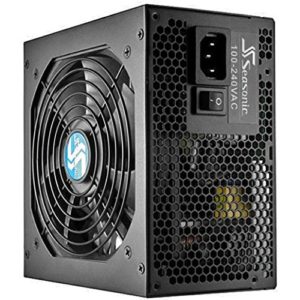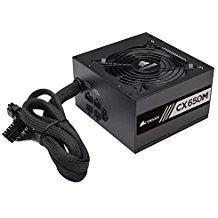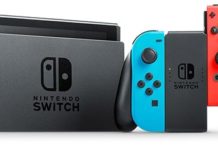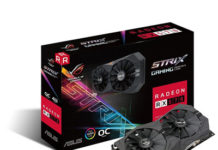
What is the best bang-for-buck price range?
$50-60 (give or take).
Can I get away with buying the cheapest power supply?
Maybe, but wouldn’t do it. The power supply connects to every part of your system and your system cannot function without it; I also wouldn’t risk frying my parts. The cheapest ones often lack features which I will mention.

What are the benefits of high-end power supplies?
Positively reviewed high-end power supplies ($90+) tend to have a variety of benefits: full modularity, support for very high wattages, near-silent fans and highest efficiency. However, they are best suited for high-end builds and not for everybody.
How many watts do the parts of a PC consume?
Typically, modern desktop CPU’s consume 50-60 watts (90-100 watts if overclocked). Video cards consume from 50-200 watts of power. GTX 1050, 1060 and 1070 consume 75, 120 and 150 watts respectively.
Other parts don’t consume much power. Hard drives consume 5-10 watts. Fans consume ~2 watts. RAM consumes ~3-5 watts per stick. USB ports consume 0.5-5 watts, assuming that they are not powering hungry devices.
What wattage power supply should I buy?
You want some headroom of at least 20%. (i.e. if your parts consume 300 watts, get at least a 400 watt power supply)
If you’re not using a video card, 150-300w is a good range. 500-550w should plenty for most builds with a video card, unless, perhaps, the video card consumes over 150w. 700w+ power supplies are only needed for very high-end video cards such as the GTX 1080 Ti.
What sizes do power supplies come in?
| ATX | SFX | Pico | |
| Dimensions | 6″ x 5.5″ x 3.5″ | 4.9″ x 3.9″ x “2.5” | External power brick (like a laptop charger) |
| Wattage (Generally) |
up to 1200w | up to 700 | up to 300 |
| Typical Price Range | $40+ | $90+ | $50-75 (both unit and the external power brick) |
| Noise Under Hight Loads | Quiet (with a good power suppy) | Fan will have to spin louder. | N/A |
| Used For | Most desktop PC’s in general. | Small form factor performance PC’s which can afford the expense. | Tiny compact office PC’s or streaming HTPC’s. |
What do “Bronze”, “Silver”, “Gold” and “Platinum” ratings mean?
These are ratings for efficiency. The acceptable standard is 80% or higher efficiency. In normal loads Bronze is 82%, Silver is 85%, Gold is 87%, Platinum is 90% and Titanium is 92%. The higher percentage the better, however, the differences between them, on you PC’s temperature and your electric bill, are marginal. Get as higher color rating if you ca
Non modular vs. Semi-Modular vs. Fully Modular?
| Non-Modular | Semi-Modular | Fully Modular |
| All cables are attached to the power supply and cannot be removed whether you plan on using them or not. | Some cables can be removed but others are attached. Typically, only the absolutely necessary cables are non-modular, so it’s not a major problem | All cables are detachable and replaceable. |
| The least expensive. | A little bit more expensive, but definitely worth it. | Further adds to the cost, but can be worth it for enthusiasts |
| These types of power supplies look like a bunch of octopus tentacles. It doesn’t look appealing for windowed cases. They can restrict airflow in smaller builds. | It still can come with that big ugly snake cable, but the other cumbersome cables can be removed. In terms of performance and functionality, this is the most optimal purchase. | For those who want power supply cables of a different color/size/length, this is a good option aesthetically. |
What are my options for a low-noise power supply?
First, you want a power supply with a quiet fan. You can find reviews on the internet which measure the decibels of sound. Fanless power supplies are dead-silent, but easily expect to pay double price ($140) for one. Generally, you want your power supply to be in the 20-30 db range and not exceeding 40. For builds which are trying to be silent, the power supply could easily end up being the loudest part, so knowing the decibel range is a good idea. Although, the majority of people will probably be fine just by checking website reviews general opinions on the noise level. It is also possible to replace the fan from inside the supply, although it will likely require some technical knowhow.
Second, go for more energy efficient CPU’s and video cards that fit your needs. Third, it is (more often than not) a good idea to buy a power supply that supports more wattage than you need. Power supplies are designed to run their fans at a certain percentage of the load (i.e. at 50% capacity). As a result, getting a power supply that has an extra 100 or 200 more watts than you need will often allow its fans to run at slower speeds.
What are the best companies for buying a power supply from?
Seasonic is generally the most reputable brand, although Corsair, Silverstone, Be Quiet and others also have reliably good offerings.
Here is a succinct tier list, comparing good and bad models/brands of power supplies, authored by someone which much more knowledge than myself.
Can I buy a power supply from the used market?
You can, but of course, there may be issues regarding warranty coverage and how the prior owner took care of their system. I wouldn’t object if it were a good quality power supply at a great discount, but in my experience, buying used usually isn’t that much cheaper than buying new.
Do power supplies become obsolete like other parts?
Generally, no. There are steady improvements along the way, but a good power supply can easily last 5-10+ years before being replaced. I suspect that fully modular, low-noise and SFX power supplies will increase in prevalence over the next 5 years as people are become more interested in compact builds. The major hurdle is price, and generally, the parts to building a power supply do not get much cheaper. On the positive side, processors and video cards generally consume less power with each new generation of technology, so you probably won’t need to upgrade to a larger watt capacity power supply.



